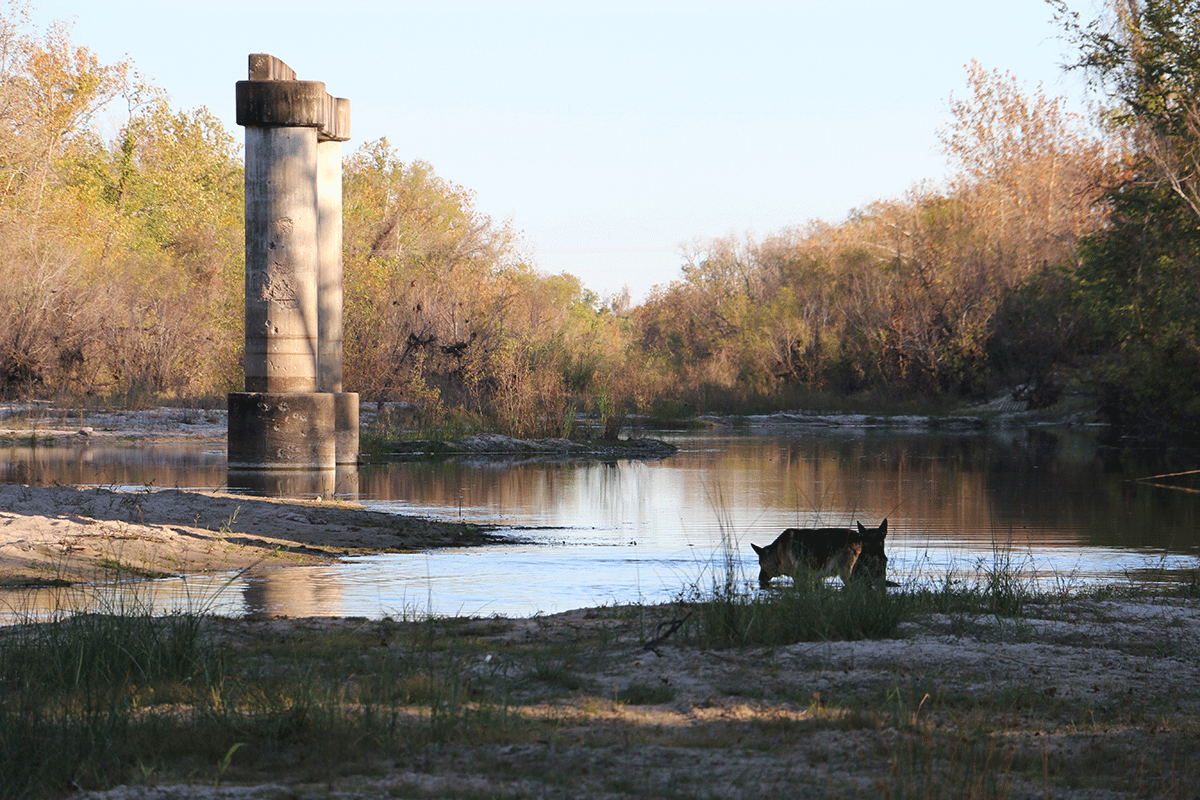Photo by Anne Rokyta: Coleto Creek at US Highway 77 with German Shepherds, Oso and Maya.
December 21, 2017 was warm, an occurrence happening more and more frequently lately. The weather was sunny, and temperatures hovered around 80°F (~27°C). It was a perfect first day of winter for fish collecting.
Our nephew and his family were in Goliad for Christmas with my sister and brother-in-law, neighbors to our farm. Darin Rokyta (nephew), Anne (his wife), Sylvie (their three-and-a-half-year-old), our German Shepherds (Oso and Maya), and I went collecting on Coleto Creek at the US 77 crossing.
Sylvie enjoyed the outing, collecting rocks, sticks, and shells and playing in the warm winter waters of Coleto Creek.


Coleto Creek, a tributary of the Guadalupe River arises near Yorktown, Texas, and flows through DeWitt, Goliad, and Victoria Counties. Coleto is a sandy bottom, clear creek and hosts an amazing variety of fishes, including many estuarian fish such as mullet (Mugil cephalus) and silversides (Menidia beryllina), as well as invertebrates such as blue crab (Callinectes sapidus). At the US 77 crossing, Coleto is several miles below a dam creating Coleto Creek Reservoir, a 3,100-acre lake. The dam creating the lake was completed in 1980 and has dramatically altered the fauna of the creek above the lake.
We didn’t have lots of time, so we only seined four locations. We picked two main flow locations and two backwater locations.


The yield was interesting to say the least. Here’s a list of the species we netted:
- Poecilia latipinna Sailfin Molly
- Poecilia formosa Amazon Molly
- Lepomis macrochirus Bluegill
- Lepomis megalotus Longear Sunfish
- Lepomis macrolophus Redear Sunfish
- Lepomis cyanellus Green Sunfish
- Lepomis gulosus Warmouth
- Fundulus chrysotus Golden Topminnow
- Lucania goodei Bluefin Killifish
- Gambusia affinis Mosquitofish
- Herichthys cyanoguttatus Texas Cichlid
- Cyprinodon variegatus Sheepshead Minnow
- Juvenile shiners, probably of the genus Notropis
Granted, all the Lepomis were juveniles and very difficult to identify. But, I’m pretty sure about all but the Redear Sunfish. It’s also possible some are hybrids; I’ve found Blue Gill/Green Sunfish hybrids in the creek before.
The big surprises were the Lucania goodei (see my blog: http://goliadfarms.com/lucania-goodei-the-blue-fin-killifish/) and Poecilia formosa. I’ve seined Coleto Creek for decades and hadn’t seen P. formosa in the creek before. In case you aren’t familiar with it, this species is a unisexual (only females) species. The females produce cloned offspring, but require mating with either P. latipinna or P. mexicana males. The males contribute no DNA, but are necessary to trigger embryogenesis. I’ll blog about this species soon and provide more information.
The Poecilia latipinna we caught were all juveniles and young (sub) adults. They looked nothing like the mollies above the dam. In fact, they most resembled P. latipinna I’d collected decades ago in the Guadalupe River at Riverside Park in Victoria. I’ve searched for those fish many times since the massive 1998 floods on the Guadalupe River to no avail. But, I think the mollies we collected may be from that population. I hope so and will see as they grow up. It’s certainly feasible since Coleto Creek flows into the Guadalupe River a few miles downstream of US 77. And, Coleto Creek avoided the worst of the 1998 flood.
Fundulus chrysotus, along with F. notatus, are two very common killifish in Coleto. We saw, but didn’t catch, F. notatus. United States Geological Survey (USGS) considers F. chrysotus to be introduced into Coleto Creek (see: https://nas.er.usgs.gov/queries/factsheet.aspx?SpeciesID=684), while it considers F. notatus to be native to Coleto Creek.
Gambusia affinis is the ubiquitous Mosquitofish, found most everywhere, either natively or introduced. USGS considers it native to Coleto Creek.
Herichthys cyanoguttatus, the Texas Cichlid, is not native to the creek, but has been naturalized there for a long time.
Cyprinodon variegatus is a common coastal pupfish, the Ninjas of the pupfishes and one of the meanest fish I’ve ever kept. It’s been common in Coleto Creek for as long as I can remember, at least five decades. It was one of the first native fish, along with Gambusia affinis, I kept. It is now absent from above the dam; at least I haven’t found it there. I wonder if it is occasionally extirpated from the creek and subsequently recolonizes from the coast where it is very common in the bays. The dam would have prevented recolonization of the creek above the dam.
We got tons…well a lot…of juvenile shiners. There are 25+ species of Notropis found in Texas. I for one have never been able to identify juvenile shiners.
We also got some grass shrimp, genus Palaemonetes. I’ll try to identify the species and blog about it in the future.
We’ll certainly collect this location again when we have more time.
Good fishkeeping!


Leave a Reply